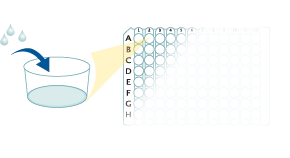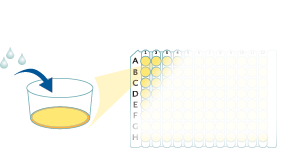Mouse Clusterin Quantikine ELISA Kit Summary
Product Summary
Recovery
The recovery of mouse Clusterin spiked into various matrices was evaluated.
| Sample Type | Average % Recovery | Range % |
|---|---|---|
| Cell Culture Supernates (n=4) | 101 | 90-111 |
| Cell Lysates (n=4) | 106 | 95-117 |
Linearity
Scientific Data
Product Datasheets
Preparation and Storage
Background: Clusterin
Clusterin, also known as Apolipoprotein J, Sulfated Glycoprotein 2 (SGP-2), TRPM-2, and SP-40, is a secreted multifunctional protein that was named for its ability to induce cellular clustering. It binds a wide range of molecules and may function as a chaperone of misfolded extracellular proteins. It also participates in the control of cell proliferation, apoptosis, and carcinogenesis (1, 2). Clusterin is expressed in adult testis, ovary, adrenal gland, liver, heart, brain, and in many epithelial tissues during embryonic development (3). Mouse Clusterin is synthesized as a precursor that contains two coiled coil domains, two nuclear localization signals (NLS), and one heparin binding domain (4-6). Intracellular cleavages of the precursor remove the signal peptide and generate comparably sized alpha and beta chains which are secreted as an approximately 80 kDa N-glycosylated and disulfide-linked heterodimer (7-9). Mature mouse Clusterin shares 77% and 93% amino acid sequence identity with human and rat Clusterin, respectively.
Assay Procedure
Refer to the product- Prepare all reagents, standard dilutions, and samples as directed in the product insert.
- Remove excess microplate strips from the plate frame, return them to the foil pouch containing the desiccant pack, and reseal.
- Add 50 µL of the appropriate Assay Diluent to each well.
- Add 50 µL of Standard, Control, or sample to each well. Cover with a plate sealer, and incubate at room temperature for 2 hours on a horizontal orbital microplate shaker.
- Aspirate each well and wash, repeating the process 4 times for a total of 5 washes.
- Add 100 µL of Conjugate to each well. Cover with a new plate sealer, and incubate at room temperature for 2 hours on the shaker.
- Aspirate and wash 5 times.
- Add 100 µL Substrate Solution to each well. Incubate at room temperature for 30 minutes on the benchtop. PROTECT FROM LIGHT.
- Add 100 µL of Stop Solution to each well. Read at 450 nm within 30 minutes. Set wavelength correction to 540 nm or 570 nm.





Citations for Mouse Clusterin Quantikine ELISA Kit
R&D Systems personnel manually curate a database that contains references using R&D Systems products. The data collected includes not only links to publications in PubMed, but also provides information about sample types, species, and experimental conditions.
4
Citations: Showing 1 - 4
Filter your results:
Filter by:
-
Apolipoprotein�J is a hepatokine regulating muscle glucose metabolism and insulin sensitivity
Authors: JA Seo, MC Kang, WM Yang, WM Hwang, SS Kim, SH Hong, JI Heo, A Vijyakumar, L Pereira de, A Uner, H Huang, SH Lee, IS Lima, KS Park, MS Kim, Y Dagon, TE Willnow, V Aroda, TP Ciaraldi, RR Henry, YB Kim
Nat Commun, 2020-04-24;11(1):2024.
Species: Mouse
Sample Types: Serum
-
Concomitant memantine and Lactobacillus plantarum treatment attenuates cognitive impairments in APP/PS1 mice
Authors: QJ Wang, YE Shen, X Wang, S Fu, X Zhang, YN Zhang, RT Wang
Aging (Albany NY), 2020-01-06;12(1):628-649.
Species: Mouse
Sample Types: Plasma
-
Clusterin Seals the Ocular Surface Barrier in Mouse Dry Eye.
Authors: Bauskar A, Mack W, Mauris J, Argueso P, Heur M, Nagel B, Kolar G, Gleave M, Nakamura T, Kinoshita S, Moradian-Oldak J, Panjwani N, Pflugfelder S, Wilson M, Fini M, Jeong S
PLoS ONE, 2015-09-24;10(9):e0138958.
Species: Mouse
Sample Types: Tears
-
Analysis of the hippocampal proteome in ME7 prion disease reveals a predominant astrocytic signature and highlights the brain-restricted production of clusterin in chronic neurodegeneration.
Authors: Asuni A, Gray B, Bailey J, Skipp P, Perry V, O'Connor V
J Biol Chem, 2013-12-23;289(7):4532-45.
Species: Mouse
Sample Types: Plasma
FAQs
No product specific FAQs exist for this product, however you may
View all ELISA FAQsReviews for Mouse Clusterin Quantikine ELISA Kit
There are currently no reviews for this product. Be the first to review Mouse Clusterin Quantikine ELISA Kit and earn rewards!
Have you used Mouse Clusterin Quantikine ELISA Kit?
Submit a review and receive an Amazon gift card.
$25/€18/£15/$25CAN/¥75 Yuan/¥2500 Yen for a review with an image
$10/€7/£6/$10 CAD/¥70 Yuan/¥1110 Yen for a review without an image




